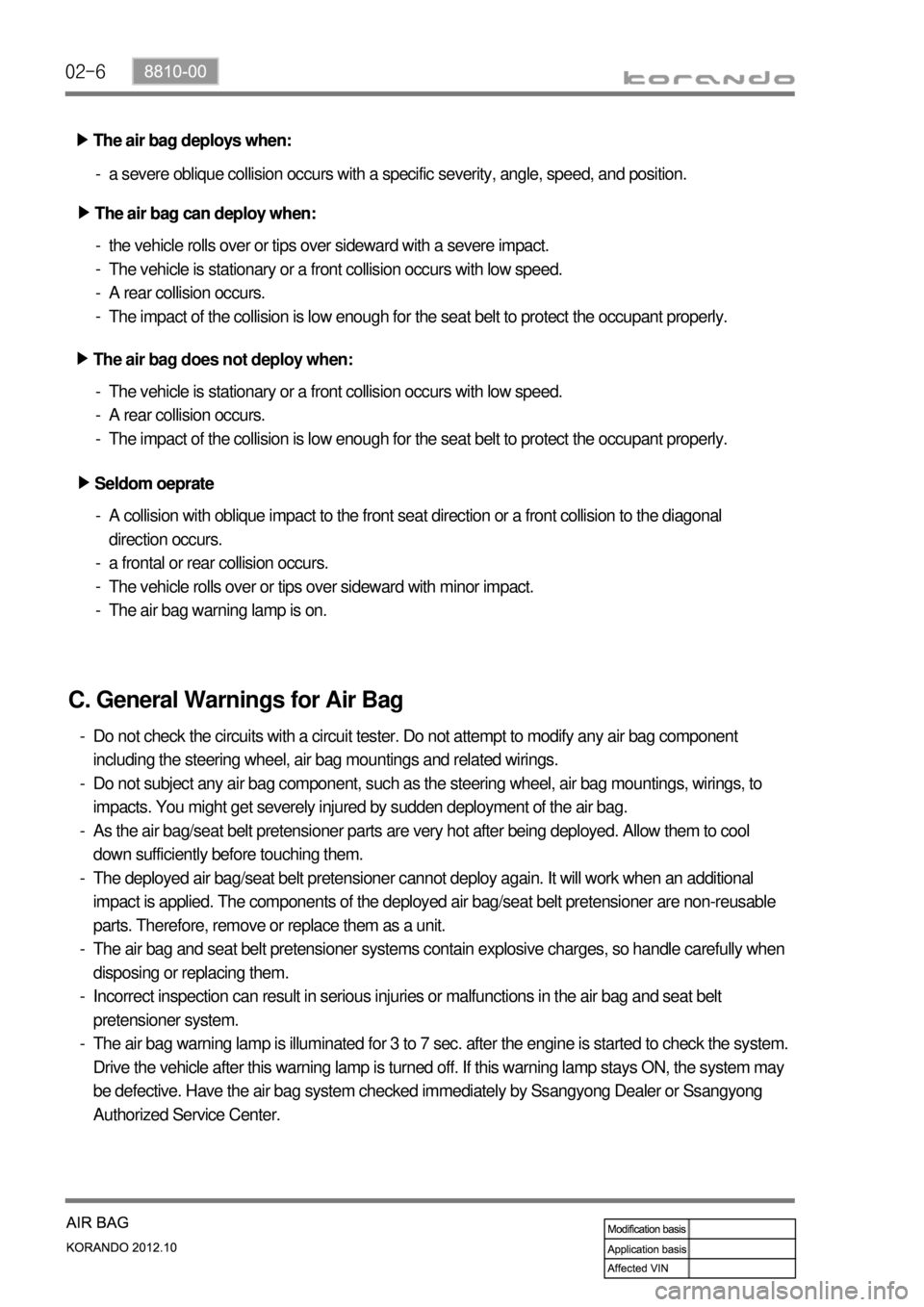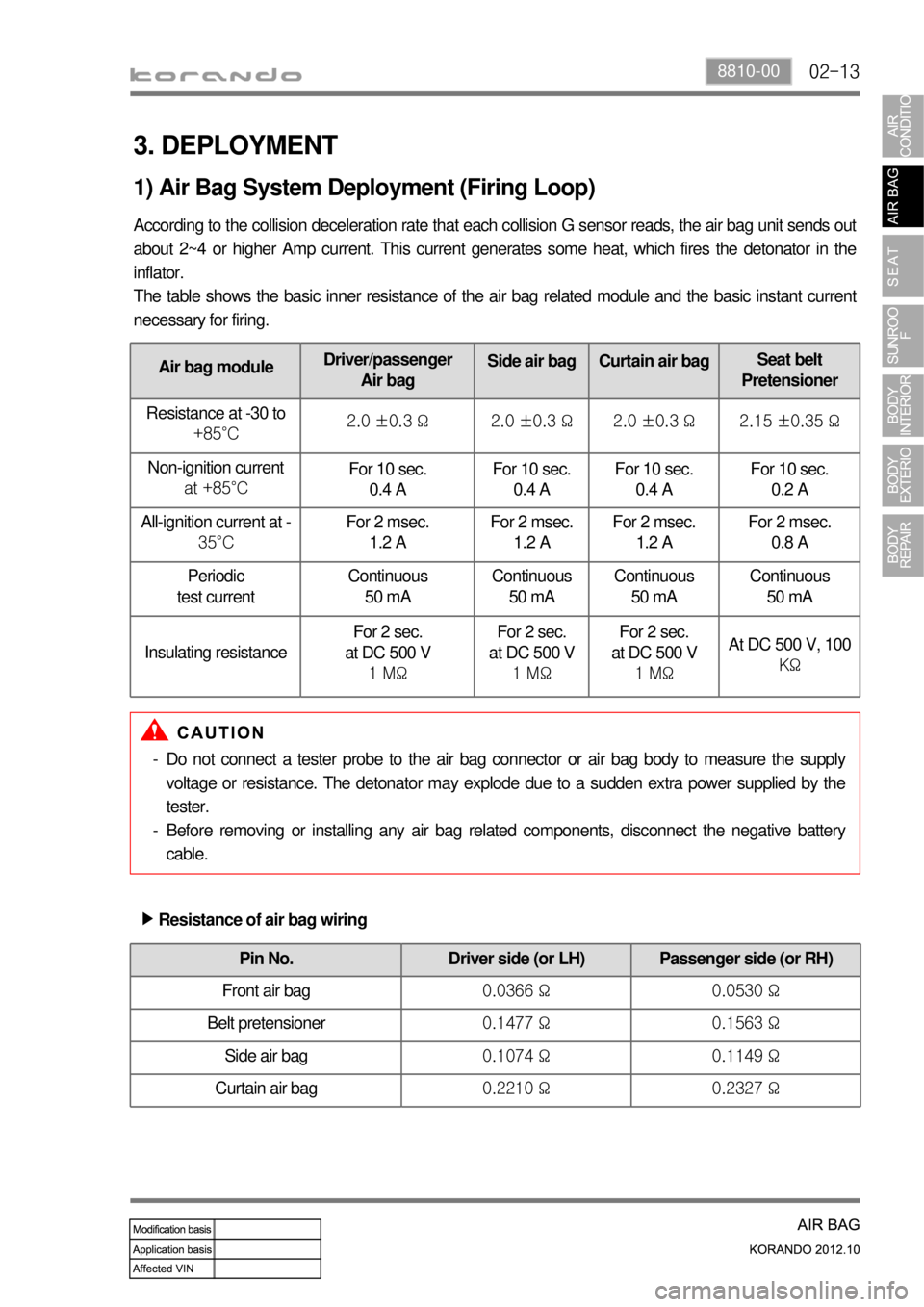Page 543 of 1082
02-58410-00
2. CHECKING CABLES AND WIRES
Check for loose connection or rust.
Check terminals and wires for corrosion due to electrolyte leakage.
Check terminals and wires for open circuit.
Check the wire insulation and coat for damage, cracks or deterioration.
Check if the conductive parts of the terminals do not contact with vehicle body or other metal parts.
Check that the grounding part has continuity with mounting bolts and vehicle body.
Check that wires are properly routed.
Make sure that wires are securely fixed to avoid contact with sharp body parts and high-temperature
parts, such as the exhaust manifold and exhaust pipes.
The rotating parts, such as fan pulley and fan belt, perturbative parts and wiring should be secured
tightly at regular intervals.
Secure the wiring between the fixed parts, such as the vehicle body, and vibrating parts, such as the
engine, after slackening it slightly to prevent it from being damaged. -
-
-
-
-
-
-
-
-
-
Page 554 of 1082
02-16
2) Interior Fuse Box
The interior fuse box is located in the left side of the instrument panel. To remove this fuse box,
disconnect the main wiring first.
Capacity and name of interior fuse and relay ▶
Page 742 of 1082
06-318510-00
Multifunction wiper switches
2) Multifunction Switch
Multifunction light switches
Light switch
Front wiper switch
Wiper speed dial
Rear wiper switch Front fog lamp switch
Front auto washer switch The multifunction switch contains the auto washer and wiper switch, front fog lamp switch and auto
hazard warning flasher switch. For the vehicle with air bag, since the contact coil is fitted to the upper part
of the multifunction switch and ESP steering wheel angle sensor is fitted to upper part of the contact coil,
pay attention to when removing and fitting or checking the wiring.
Page 893 of 1082
03-8
1) Characteristics of WM6F1 M/T
Both Forward and Reverse gears use the helical gear and are made of high-strength material.
Drives the clutch with a concentric slave cylinder mounting bolt.
Shifting the transmission gears is performed through the remote control cable.
A pull type clutch is used for Reverse gear shifting.
Features triple/double/single synchronization. -
-
-
-
-
Clutch housing
Transmission case
Input shaft
Concentric slave cylinder
Shift lever
Selector lever
Wiring bracket
Neutral switch
Backup lamp switch
Reverse idle shaft mounting bolt 1.
2.
3.
4.
5.
6.
7.
8.
9.
10.Control guide bolt
Oil filler plug (for servicing)
Oil drain plug
Oil filler plug (for manufacturing)
Air breather
Detent pin (for securing shift fork)
Oil seal (RH)
Oil seal (LH)
Control housing 11.
12.
13.
14.
15.
16.
17.
18.
19.
Page 1005 of 1082
01-4
2. MAJOR CHANGES
1) Heater & Evaporator Module (Wiring Specification)
The driving circuit for the manual A/C ambient temperature sensor is added, giving the change to the
heater and evaporator module.
Ambient temperature sensor signal wiring
added to vehicle wiring connecting
connector (2 circuits)
: manual A/CBlower max signal wiring added to
vehicle wiring connecting connector
(1 circuit)
: manual A/C & FATC
Manual A/C: Wiring pin added to controller assembly connector
FATC: Wiring pin added to existing connector of controller assembly
Page 1019 of 1082
02-38810-00
1. SPECIFICATIONS
Operating voltage 9 to 16 V
System diagnosis and SDM self diagnosis voltage 9 to 16 V
Ignition voltage for side air bag and pretensioner 9 to 16 V
Communication voltage for front impact sensor 9 to 16 V
Communication voltage for side impact sensor 9 to 16 V
Operating temperature -40℃ ~ 85℃
Storage temperature -40℃ ~ 90℃
Ignition temperature -30℃ ~ 85℃
Overvoltage protection 24 V
2. MAJOR REPLACEMENT PARTS AFTER AIR BAG
DEPLOYMENT
A. In Case Of Front Air Bag Deployment
Air bag unit and its wirings (including connectors), seat belt pretensioner and its wirings (including
connectors), all front air bags, instrument panel, front impact sensor and other damaged components
B. In Case Of Curtain Air Bag Deployment
Deployed curtain air bag, air bag unit and its wiring (including connector), impact G sensor assembly for
curtain air bag, damaged trim, seat and roof headlining
Page 1022 of 1082

02-6
Seldom oeprate ▶The air bag deploys when: ▶
The air bag can deploy when: ▶a severe oblique collision occurs with a specific severity, angle, speed, and position. -
A collision with oblique impact to the front seat direction or a front collision to the diagonal
direction occurs.
a frontal or rear collision occurs.
The vehicle rolls over or tips over sideward with minor impact.
The air bag warning lamp is on. -
-
-
-the vehicle rolls over or tips over sideward with a severe impact.
The vehicle is stationary or a front collision occurs with low speed.
A rear collision occurs.
The impact of the collision is low enough for the seat belt to protect the occupant properly. -
-
-
-
Seldom oeprate ▶The air bag deploys when: ▶
The air bag can deploy when: ▶
The air bag does not deploy when: ▶
The vehicle is stationary or a front collision occurs with low speed.
A rear collision occurs.
The impact of the collision is low enough for the seat belt to protect the occupant properly. -
-
-
C. General Warnings for Air Bag
Do not check the circuits with a circuit tester. Do not attempt to modify any air bag component
including the steering wheel, air bag mountings and related wirings.
Do not subject any air bag component, such as the steering wheel, air bag mountings, wirings, to
impacts. You might get severely injured by sudden deployment of the air bag.
As the air bag/seat belt pretensioner parts are very hot after being deployed. Allow them to cool
down sufficiently before touching them.
The deployed air bag/seat belt pretensioner cannot deploy again. It will work when an additional
impact is applied. The components of the deployed air bag/seat belt pretensioner are non-reusable
parts. Therefore, remove or replace them as a unit.
The air bag and seat belt pretensioner systems contain explosive charges, so handle carefully when
disposing or replacing them.
Incorrect inspection can result in serious injuries or malfunctions in the air bag and seat belt
pretensioner system.
The air bag warning lamp is illuminated for 3 to 7 sec. after the engine is started to check the system.
Drive the vehicle after this warning lamp is turned off. If this warning lamp stays ON, the system may
be defective. Have the air bag system checked immediately by Ssangyong Dealer or Ssangyong
Authorized Service Center. -
-
-
-
-
-
-
Page 1029 of 1082

02-138810-00
Air bag moduleDriver/passenger
Air bagSide air bag Curtain air bagSeat belt
Pretensioner
Resistance at -30 to
+85°C2.0 ±0.3 Ω 2.0 ±0.3 Ω 2.0 ±0.3 Ω 2.15 ±0.35 Ω
Non-ignition current
at +85°CFor 10 sec.
0.4 A For 10 sec.
0.4 AFor 10 sec.
0.4 AFor 10 sec.
0.2 A
All-ignition current at -
35°CFor 2 msec.
1.2 AFor 2 msec.
1.2 AFor 2 msec.
1.2 AFor 2 msec.
0.8 A
Periodic
test currentContinuous
50 mAContinuous
50 mAContinuous
50 mAContinuous
50 mA
Insulating resistanceFor 2 sec.
at DC 500 V
1 MΩFor 2 sec.
at DC 500 V
1 MΩFor 2 sec.
at DC 500 V
1 MΩ
At DC 500 V, 100
KΩ
3. DEPLOYMENT
According to the collision deceleration rate that each collision G sensor reads, the air bag unit sends out
about 2~4 or higher Amp current. This current generates some heat, which fires the detonator in the
inflator.
The table shows the basic inner resistance of the air bag related module and the basic instant current
necessary for firing.
1) Air Bag System Deployment (Firing Loop)
Do not connect a tester probe to the air bag connector or air bag body to measure the supply
voltage or resistance. The detonator may explode due to a sudden extra power supplied by the
tester.
Before removing or installing any air bag related components, disconnect the negative battery
cable. -
-
Pin No. Driver side (or LH) Passenger side (or RH)
Front air bag 0.0366 Ω 0.0530 Ω
Belt pretensioner 0.1477 Ω 0.1563 Ω
Side air bag 0.1074 Ω 0.1149 Ω
Curtain air bag 0.2210 Ω 0.2327 Ω
Resistance of air bag wiring ▶